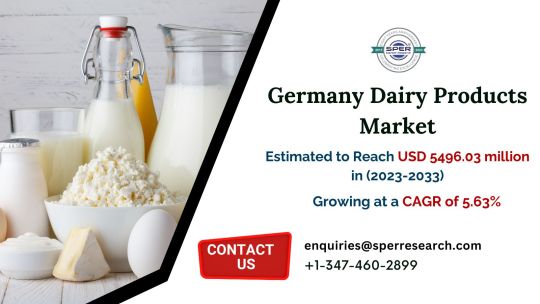#dairy alternatives market share
Explore tagged Tumblr posts
Text
Dairy Alternatives Market is expected to reach US$ 75.70 Billion by 2032
Dairy Alternatives Market Analysis Global Dairy Alternatives Market will reach US$75.70 billion by 2032, up from US$29.07 billion in 2023. It is projected to increase at a CAGR of 11.22% from 2024 to 2032. Dairy alternatives are foods and drinks that can be substituted for dairy products. They are made from plants and are regarded as healthy dairy substitutes. Soy, rice, and almond milk are the…

View On WordPress
#dairy alternatives market#dairy alternatives market by product#dairy alternatives market by source#dairy alternatives market share#dairy alternatives market size#global dairy alternatives market
0 notes
Text
Germany Dairy Products Market Revenue, Size, Share, Growth Drivers, Demand, Upcoming Trends, Challenges and Future Outlook 2033: SPER Market Research
The Germany Dairy Foods Market involves the production, distribution, and consumption of dairy products within Germany. With a strong tradition of dairy consumption and a focus on quality, the market offers a diverse range of products such as milk, cheese, yogurt, and butter. Key drivers include health consciousness, dietary preferences, and culinary traditions. Additionally, innovations in dairy processing and packaging contribute to market growth. Key players emphasize product quality, nutritional value, and sustainability to meet consumer demands effectively in this competitive market landscape.

#Dairy Foods Market#Dairy Products and Alternatives in Germany#Dairy Products in Germany#Germany Dairy Alternatives Market#Germany Dairy Foods Market Analysis#Germany Dairy Foods Market Demand#Germany Dairy Foods Market Growth#Germany Dairy Foods Market Overview#Germany Dairy Foods Market segmentation#Germany Dairy Foods Market Share#Germany Dairy Foods Market Size#Germany Dairy Foods Market Trends#Germany Dairy Free Snacks Market#Germany Dairy Market#Germany Dairy Production Market#Germany Dairy Products and Juice Market#Germany Dairy Products Food and Beverages Market#Germany Dairy Products Industry#Germany Dairy Products Market#Germany Dairy Products Market Challenges#Germany Dairy Products Market Competition#Germany Dairy Products Market Forecast#Germany Dairy Products Market Future outlook#Germany Dairy Products Market Opportunity#Germany Dairy Products Market Research Report#Germany Dairy Products Market Revenue#Germany Dairy Products Market Top Industry Players#Germany Juice Market#Germany Milk Product Market#Germany Organic Dairy Market
0 notes
Text
Global Dairy Alternative Market outlook to 2028.

The Dairy Alternative Market outlook to 2028 foresees robust growth, challenging traditional dairy product market size and market share.
#Dairy product market size#Dairy product market share#Dairy product market growth#Dairy Alternative Market
0 notes
Text
How the Plant-based Milk Market is Growing Worldwide: A Sustainable Alternatives
The global plant-based milk market size is estimated to reach USD 32.35 billion in 2030 and expand at a CAGR of 7.6% from 2024 to 2030, according to a new report by Grand View Research, Inc. The growth of the plant-based milk market is primarily driven by shifting consumer preferences towards healthier dietary choices and increasing awareness of lactose intolerance and dairy allergies. Consumers are increasingly opting for plant-based alternatives such as almond, soy, oat, coconut, and others, which offer nutritional benefits including vitamins, minerals, and proteins, without compromising on taste.

The growing adoption of vegan and flexitarian lifestyles worldwide has significantly expanded the consumer base for plant-based milk products. These dietary choices are driven by ethical considerations, environmental sustainability concerns, and perceived health benefits associated with reduced consumption of animal products is further expected to drive the market for plant-based milk during the forecast period.
The availability and convenience of plant-based milks have significantly improved, contributing to market growth. Major retailers and supermarkets now stock a wide range of plant-based milks, making them easily accessible to consumers. Online grocery platforms have also expanded their plant-based milk offerings, allowing consumers to conveniently purchase their preferred products from the comfort of their homes. This factor is further expected to drive the market for plant-based milk during the forecast period.
The plant-based milk market has seen significant expansion beyond North America and Europe, reaching new markets in Asia, Latin America, and the Middle East. In Asia, where lactose intolerance is prevalent, plant-based milks are gaining popularity as a suitable alternative to dairy. In Latin America, the growing middle class and increasing awareness of health and environmental issues are driving demand for plant-based milks.
Manufacturers in the plant-based milk market are investing in research and development to innovate and expand their product portfolios. This includes the introduction of new plant sources such as almond, soy, oat, coconut, and others, as well as fortified variants enriched with vitamins, minerals, and protein. Innovations in flavor profiles and packaging formats cater to diverse consumer preferences and convenience.
For More Details or Sample Copy please visit link @: Plant-based Milk Market Report
Plant-based Milk Market Report Highlights
Asia Pacific is expected to grow with the fastest CAGR of 8.2% over the forecast period from 2024 to 2030. The rise of vegetarianism and veganism, driven by concerns about animal cruelty, supports the demand for plant-based milks.
Based on product, the oat milk is expected to grow with the fastest CAGR of 9.4% over the forecast period. Oat milk is rich in dietary fiber, particularly beta-glucan, which has been shown to help lower cholesterol levels. Additionally, oat milk often contains higher levels of protein compared to other plant-based milks, making it a nutritious option for consumers.
Based on nature, organic plant-based milk is expected to growth with the fastest CAGR of 11.5% from 2024 to 2030. Organic plant-based milks are free from synthetic pesticides, fertilizers, and genetically modified organisms (GMOs), which appeals to health-conscious consumers.
Based on distribution channel, sales of plant-based milk proudcts through hypermarkets & supermarkets accounted for the largest share in the plant-based milk market in 2023. These retail outlets offer a wide variety of plant-based milk products, including different brands, types, and flavors. The extensive product range allows consumers to compare and choose according to their preferences, driving sales through this channel.
Gain deeper insights on the market and receive your free copy with TOC now @: Plant-based Milk Market Report
We have segmented the global plant-based milk market based on product, nature, flavor, distribution channel, and region.
#PlantBasedMilk#DairyAlternatives#VeganMilk#NonDairy#PlantBased#MilkMarket#SustainableFood#FoodInnovation#HealthyLiving#VeganTrends#LactoseFree#DairyFree#PlantBasedDiet#FoodIndustry#MarketGrowth
5 notes
·
View notes
Text






















World Milk Day
Start your day with a glass of calcium-rich milk, visit a local dairy farm, or see what milk alternatives like soy, oat, or almond milk you might enjoy.
It’s a well-known fact that milk is rich with calcium, a mineral that promotes healthy teeth and bones. June 1st is the date that has been set aside to celebrate Milk Day. And, of course, this is a celebration that can take place anywhere in the world, given that milk is a global food!
The use of milk in food and drink has been happening for thousands of years. As most people can appreciate, milk is an integral part of most people’s daily lives, and there’s an entire industry that revolves around it as well.
Milk is a liquid food rich with nutrients like calcium. It’s a food product that is primarily used by mammals during infancy. Although, in the case of humans, people tend to consume it in adulthood, as most adult humans can digest the lactose in milk.
Of course, milk isn’t only available for drinking. It’s an essential ingredient for dairy foods such as butter, cream, ice cream, and cheese. Milk can also be found as an ingredient used in other types of foods, such as bread, cakes, cereal, desserts and so much more.
There is no denying that milk has become a mainstay of most people’s diets today. It’s also one of the cheapest food products to buy, given the industrial scale of milk production in the world. Some of the largest producers of milk are the United States, India, and China.
History of Milk Day
Milk Day became a globally celebrated event on June 1st, 2001. The global celebration, in general, can be traced back to the United Nations (UN). In particular, the FAO (Food and Agriculture Organization) of the UN has been responsible for organizing and marketing World Milk Day throughout the globe.
More than two decades ago, the FAO proposed a global Milk Day to recognize the importance of milk and the role that it plays in our world. In addition, this day was also created to provide direct focus to the milk industry and publicize the various activities connected with it. In fact, the dairy industry supports the livelihoods of approximately 1 billion people throughout the world!
But even before this day was created in 2001, Milk Day was celebrated by some other nations throughout history. In the British Isles, for example, a Milk Day celebration (“Imbolc” – Celtic for “milk”) took place in the pre-Christian era.
Considering the fact that over six billion people worldwide consume milk and dairy, it’s no surprise there was a need to celebrate this healthy, delicious beverage!
How to Celebrate Milk Day
June 1st is a day that many people may want to write their diaries. Milk plays such a significant role in the world that should certainly be celebrated in style!
But what can be done to celebrate such a momentous occasion? Try out some of these ideas for enjoying Milk Day:
Get the Day Started with a Glass of Milk
Why not celebrate today with a glass of fresh, cold milk in the morning to kick-start the day?! But don’t stop there. How about enjoying a big bowl of cereal full of delicious milk?
Of course, after drinking that glass of milk, don’t forget to snap a photo of that beautiful milk mustache! Share it with the world on social media to remind everyone else to enjoy Milk Day too.
Join an Official Milk Day Celebration
As a worldwide event, Milk Day comes with all kinds of official opportunities to celebrate! In 2020, more than 400 Milk Day campaigns took place in over 68 countries all over the globe, so there should be plenty to join in with again this year. Here are some events that have taken place in previous years:
World Milk Day Milk Donation. Happening in New York State, USA, several organizations have gotten together to provide a free gallon of milk to the people in their local community who visit a dairy farm.
Live Recipes by Renowned Chefs from Around the World. This live Facebook event has been hosted by Amul, India, which is the country’s largest dairy brand, with the intention of showing the importance of milk throughout different countries and cultures.
International Dairy Federation Raise a Glass Event. Hosted by the IDF in Brussels, Belgium, this event involved hosting a toast to milk from people all around the world.
Check the World Milk Day website to get access to all the needed information to make plans for this day.
Visit a Local Dairy or Farm
For those who have some extra time, especially those with kids who are ready to learn, consider visiting a local dairy to learn the process of milking cows and collecting the milk. This will also lead to learning about pasteurizing and homogenizing milk, methods used to filter milk and keep it long-lasting.
If there are no cow farms nearby, consider visiting a smaller farm that has goats. It’s still possible to learn about everything milk-oriented but may be more accessible because they might be smaller and locally owned.
Enjoy Other Milk Products
For lunch, why not have a mozzarella or Margherita pizza and drink a glass of chocolate milk to wash it down? After that, those who are still feeling hungry could always have some delicious ice cream for dessert!
Other options for enjoying milk products on this day (and every day!) include yogurt, sour cream, butter, custard, cream and all of the recipes that can be made from them.
Try a Milk Alternative
For folks who have trouble digesting dairy easily, why not try other non-dairy milk alternatives? Here are some popular options:
Soy Milk. A favorite as one of the early milk alternatives, this one is made from soybean plants that grow fairly prolifically in many places.
Almond Milk. Made by crushing almonds and blending them with water, and then straining out the mix to remove any solids that are left, this nutty milk is filled with protein.
Coconut Milk. This one uses the white, fleshy part of the coconut, grating it and soaking it in water. The cream rises and is skimmed off, then what’s left is strained to extract the coconut milk.
Whether with a milk product or a dairy alternative, celebrating World Milk Day can be loads of fun!
Source
#chocolate cake#Rice pudding with cinnamon#flan de huevo#Pudim flan#Crème caramel#chocolate pie#whipped cream#dessert#Spain#travel#original photography#summer 2021#vacation#World Milk Day#1 June#WorldMilkDay#Princess cake#Strawberry Shortbread#USA#Strawberry Milkshake#Chocolate Banana Milkshake#Berries&Cream#Coconut Cream Pie#Banana Cream Pie#Strawberry Cheesecake Milkshake#Pecan Praline Milkshake#food#restaurant#Coconut Cream Pie Cheesecake#Pecan Pie
3 notes
·
View notes
Text
Cling Film Market Trends, Segmentation, Outlook, Industry Report to 2031
The cling film market is anticipated to grow at a CAGR of 5.2% during the anticipated time frame and reach USD 8.72 billion by 2027. Food items are routinely wrapped and preserved with cling film, a thin plastic sheet also known as plastic wrap or food wrap.
The sector is developing mainly due to rising customer demand for packaged and handy items as well as increased consumer education on food safety and storage. Cling film is frequently used in homes, restaurants, and the food processing and packaging industries to preserve food for a longer period of time.
Low-density polyethylene (LDPE), polyvinyl chloride (PVC), and linear low-density polyethylene (LLDPE) are the three material kinds that make up the market. Because of its exceptional clarity, strength, and flexibility, PVC is the cling film material that is used the most frequently.
For More Insights on this Market, Get A Sample Report @ https://www.futuremarketinsights.com/reports/sample/rep-gb-2654
The effects of cling film on the environment, however, are also a worry. In landfills, plastic cling film takes hundreds of years to decompose, which can contribute to environmental contamination. Due to this, there is an increasing need for cling film substitutes like silicone food covers and beeswax wraps.
Overall, it is anticipated that the cling film market will expand over the next few years due to the rising demand for practical and secure food packaging solutions. To fulfil the changing expectations of consumers, the industry will also need to address worries about the environmental impact of plastic cling film and investigate sustainable alternatives.
Market Benefits
The study provides an in-depth analysis of the global Cling Film market along with the current trends and future estimations to elucidate the imminent investment pockets.
The key market players along with their strategies are thoroughly analyzed to understand the competitive outlook of the industry.
An extensive analysis of the market based on application assists in understanding the trends in the industry.
The report presents a quantitative analysis of the market from 2021 to 2031 to enable stakeholders to capitalize on the prevailing market opportunities.
Key Takeaways from the Cling Film Market Study
Polyvinyl chloride is expected to create incremental opportunity of US$ 508.3 million by 2031. It is cost-effective and suitable for recycling processes.
Cling film products up to 9 microns in thickness is estimated to increase 1.7 times by the end of 2031, attributed to clear and transparent packaging for food product displays.
Canada is expected to reflect faster growth in North America, with a 6.5% CAGR due to the presence of key players and the availability of technological advancements.
Germany leads Western Europe accounting for 26% of the value share by 2031, owing to relatively higher production capacity.
China will continue to dominate APEJ holding over 40% of the market through 2031, supported by a large base of end users and manufacturers.
Are you looking for customized information related to the latest trends, drivers, and challenges? @ https://www.futuremarketinsights.com/customization-available/rep-gb-2654
Competitive Landscape
Berry Global Group, Inc.
Intertape Polymer Group (IPG)
Gruppo Fabbri Vignola S.p.A
Kalan SAS
Fine Vantage Limited
Rotofresh – Rotochef s.r.l.
Manuli Stretch S.p.A.
Cling Film Market by Category
By Material type:
Polyethylene
Low Density Polyethylene (LDPE)
High Density Polyethylene (HDPE)
Linear Low Density Polyethylene (LLDPE)
Bi-axially Oriented Polypropylene (BOPP)
Polyvinyl Chloride
Polyvinylidene Chloride
Others
Speak to Our Analyst @ https://www.futuremarketinsights.com/ask-the-analyst/rep-gb-2654
By Thickness:
Up to 9 micron
9 to 12 micron
Above 12 micron
By End Use:
Food
Meat
Seafood
Baked Foods
Dairy Products
Fruits & Vegetables
2 notes
·
View notes
Text
UHT Dairy Market Exploring Supply Chain and Regulatory Vulnerabilities
The UHT (Ultra-High Temperature) dairy products market has experienced significant growth in recent years, offering extended shelf life and convenience to consumers globally. However, despite its many advantages, the market faces several vulnerabilities that could impact its continued success. These vulnerabilities stem from a range of challenges, including environmental concerns, supply chain disruptions, regulatory pressures, and evolving consumer preferences. Addressing these vulnerabilities is crucial for the market's long-term sustainability and growth.
1. Environmental Impact and Sustainability Concerns
The environmental impact of UHT dairy production is one of the most significant vulnerabilities facing the market. While UHT dairy products offer convenience and long shelf life, the packaging used for these products, such as tetra packs and plastic containers, contributes to plastic waste and environmental degradation. The demand for eco-friendly packaging is on the rise, as consumers become more conscious of the environmental impact of their purchases. Manufacturers in the UHT dairy products market are increasingly under pressure to adopt sustainable packaging solutions and reduce their carbon footprints. Failure to respond to this demand for sustainability could result in consumer backlash and regulatory challenges, undermining the market's growth potential.
2. Supply Chain Disruptions and Raw Material Sourcing
Supply chain vulnerabilities also pose a significant challenge to the UHT dairy products market. The dairy industry relies heavily on a steady supply of raw materials, such as milk, which can be affected by various external factors, including weather conditions, disease outbreaks in livestock, and geopolitical instability. Additionally, transportation and logistics disruptions, such as those caused by the COVID-19 pandemic, can result in delays and increased costs for UHT dairy manufacturers.
For instance, any fluctuations in milk supply or quality can directly impact the production of UHT dairy products, potentially leading to price increases or shortages in the market. The rising costs of raw materials and transportation can reduce the profitability of UHT dairy products and challenge the market’s ability to keep prices competitive.
3. Health and Wellness Trends
While UHT dairy products are widely appreciated for their convenience, the increasing consumer preference for plant-based diets and healthier alternatives poses a vulnerability to traditional dairy products. As more consumers opt for non-dairy substitutes like almond milk, oat milk, and soy milk, the demand for UHT dairy products could face a decline, particularly in regions where plant-based alternatives are gaining traction.
Moreover, concerns over the high sugar content in flavored UHT dairy beverages and concerns regarding the environmental impact of animal agriculture have led some consumers to seek healthier and more sustainable options. UHT dairy manufacturers may need to adapt to these evolving consumer preferences by offering low-sugar, organic, and plant-based UHT options to maintain market share.
4. Regulatory Pressures and Labeling Standards
The regulatory environment surrounding the dairy industry is another vulnerability that could impact the growth of the UHT dairy products market. Different countries have varying regulations and standards for food safety, labeling, and marketing, which can create challenges for UHT dairy manufacturers, particularly those involved in international trade.
In many regions, there is increasing scrutiny over labeling practices, with consumers demanding more transparency regarding product ingredients, sourcing, and production methods. UHT dairy products, particularly those that contain preservatives or artificial additives, may face more stringent regulations and scrutiny. Non-compliance with these regulatory standards can result in reputational damage, loss of consumer trust, and legal consequences, impacting market growth.

5. Competition from Local and Regional Dairy Products
In many emerging markets, UHT dairy products face strong competition from local and regional dairy products, which are often perceived as fresher and more authentic. While UHT products have a longer shelf life, consumers in some regions may still favor locally produced dairy due to cultural preferences or the perception that locally produced dairy is healthier and of higher quality.
For example, in countries with a rich dairy culture, such as India, China, and parts of Europe, fresh milk and dairy products may be preferred over UHT alternatives. Additionally, in regions with a strong emphasis on traditional farming practices, there is often a preference for dairy that has not undergone industrial processing methods like UHT. This cultural preference can hinder the growth of UHT dairy products in specific markets.
6. Price Sensitivity and Economic Factors
Economic factors, such as inflation, fluctuations in disposable income, and changes in consumer spending behavior, can affect the UHT dairy products market. While UHT products are generally cost-effective due to their long shelf life and efficient production methods, price sensitivity in some regions could influence purchasing decisions.
In developing economies, where consumers are more price-conscious, the higher cost of UHT dairy products compared to locally sourced fresh dairy could deter some customers from choosing UHT options. As competition in the dairy sector intensifies, UHT dairy producers may be forced to reduce prices, which could erode profitability and impact market growth.
Conclusion
The UHT dairy products market is undoubtedly a growing and lucrative segment in the global dairy industry. However, it is not without vulnerabilities. Environmental concerns, supply chain disruptions, shifting consumer preferences, and regulatory pressures are all factors that could influence the future of the UHT dairy market. Manufacturers and stakeholders in the market must address these vulnerabilities proactively by adopting sustainable practices, diversifying product offerings, and adhering to evolving regulations. By doing so, they can ensure the continued growth and success of UHT dairy products in an increasingly competitive and dynamic global market.
0 notes
Text
Plant-Based Food Market Forecasted to Surpass $113.1 Billion by 2031
Meticulous Research®—a leading global market research company, published a research report titled, ‘Plant-based Food Market by Type (Dairy Alternatives, Plant-based Meat, Meals, Confectionery, Beverages, Egg Alternatives, Seafood), Source (Soy, Wheat, Pea, Rice), Distribution Channel (B2B, B2C [Convenience Store, Online Retail])—Global Forecast to 2031.’
According to this latest publication from Meticulous Research®, the plant-based food market is expected to record a CAGR of 12.3% from 2024 to 2031 to reach $113.1 billion by 2031. This market's growth is driven by the increasing intolerance for animal protein amongst consumers, the growing vegetarian population, the rising number of venture investments in plant-based food companies, innovation in food technology, and the growing focus on animal welfare and sustainability. In addition, the increasing number of research & development and new product launches by plant and protein alternative manufacturers and emerging economies, such as Asia-Pacific, Latin America, and the Middle East & Africa, are expected to create lucrative opportunities for players operating in this market.
However, factors such as the comparatively higher price range of meat substitutes, significant preference for animal-based products, and consumer preference for soy and gluten-free products are expected to hinder the growth of this market to a notable extent.
Key Players
The key players operating in the plant-based food market are Beyond Meat Inc. (U.S.), Impossible Foods Inc. (U.S.), Danone S.A. (France), Garden Protein International, Inc. (Canada), Amy's Kitchen Inc. (U.S.), Plamil Foods Ltd. (U.K.), The Hain Celestial Group, Inc. (U.S.), Sahmyook Foods (South Korea), Sanitarium Health and Wellbeing Company (Australia), Daiya Foods Inc. (Canada), Earth's Own Food Company Inc. (Canada), Lightlife Foods, Inc. (U.S.), Taifun –Tofu GmbH (Germany), Atlantic Natural Foods LLC (U.S.), VBIte Food Ltd (U.K.), Nutrisoy Pty Ltd. (Australia), Nestlé S.A. (Switzerland), Unilever PLC (U.K.), Sophie’s Kitchen (U.S.), and Eat Just, Inc. (U.S.).
The plant-based food market is segmented by type, source, distribution channel, and geography. The study also evaluates industry competitors and analyses the market at the regional and country levels.
Download Sample Report Here @ https://www.meticulousresearch.com/download-sample-report/cp_id=5108
Based on type, the plant-based food market is segmented into dairy alternatives, meat substitutes, plant-based meals, plant-based baked goods, plant-based confectionery, plant-based beverages, egg substitutes, fish and seafood alternatives, and other plant-based foods. In 2024, the dairy alternatives segment is expected to account for the largest share of the plant-based food market. The large market share of this segment is attributed to factors such as the increasing number of lactose intolerant people, the growing ethical concerns amongst consumers about animal abuse in modern dairy farming practices, and the nutritional benefits offered by plant-based dairy products. However, the egg substitute segment is expected to register the highest CAGR during the forecast period.
Based on source, the plant-based food market is segmented into soy, almond, wheat, pea, rice, oat, and other sources. In 2024, the soy segment is expected to account for the largest share of the plant-based food market. The large market share of this segment is attributed to factors such as the easy and wide availability of raw materials, lower cost compared to other sources, significant demand from meat alternatives manufacturers, higher consumer acceptance level, and its wide range of applications in numerous food & beverage sectors, including meat, dairy alternative, and bakery. However, the pea segment is expected to register the highest CAGR during the forecast period.
Based on distribution channel, the plant-based food market is segmented into business-to-business and business-to-consumer. In 2024, the B2C segment is expected to account for a larger share of the plant-based food market. The large market share of this segment is attributed to factors such as the increased sales of plant-based food in well-established supermarkets and hypermarket chains, consumer preference for shopping from brick-and-mortar grocers due to easy access and availability, and the increasing consumer expenses on vegan food products. Additionally, this segment is also expected to grow at the fastest CAGR during the forecast period.
Based on geography, in 2024, Asia-Pacific is expected to account for the largest share of the plant-based food market. The leading position of North America in the plant-based food market is attributed to factors such as collaborations between international and domestic food companies, increasing awareness of protein-rich diets, booming food & beverages industry, growing economy, rapid urbanization, and the large base of vegan and vegetarian population. Additionally, this country is expected to grow at the highest CAGR during the forecast period.
Browse in depth : https://www.meticulousresearch.com/product/plant-based-food-market-5108
Key Questions Answered in the Report-
What is the current revenue generated by plant-based food globally?
At what rate is the global plant-based food demand projected to grow for the next 5–7 years?
What are the historical market sizes and growth rates of the global plant-based food market?
What are the major factors impacting the growth of this market at the regional and country levels? What are the major opportunities for existing players and new entrants in the market?
Which segments, in terms of type, source, and distribution channel, are expected to create major traction for manufacturers in this market?
What are the key geographical trends in this market? Which regions/countries are expected to offer significant growth opportunities for the manufacturers operating in the global plant-based food market?
Who are the major players in the global plant-based food market? What are their specific product offerings in this market?
What are the recent strategic developments in the global plant-based food market? How have these developments impacted market growth?
Contact Us: Meticulous Research® Email- [email protected] Contact Sales- +1-646-781-8004 Connect with us on LinkedIn- https://www.linkedin.com/company/meticulous-research
#Plant-based Food Market#Plant Food#Vegan Food Products#Vegetarian Food#Meat Substitute#Dairy Alternatives#Plant-based Products#Plant-based Diet
1 note
·
View note
Text
Dairy Alternatives Market will be US$ 75.70 Billion by 2032
The Global Dairy Alternatives Market size was valued at US$ 29.07 Billion in 2023. It is projected to increase at a CAGR of 11.22% from 2024 to 2032. Renub Research forecasted the value to be US$ 75.70 Billion by 2032. Dairy alternatives are foods and drinks that can be substituted for dairy products. They are made from plants and are regarded as healthy dairy substitutes. Soy, rice, and almond…

View On WordPress
#dairy alternatives market#dairy alternatives market by product#dairy alternatives market by source#dairy alternatives market share#dairy alternatives market size#global dairy alternatives market
0 notes
Text
A Deep Dive into the U.S. Packaged Food Market: Insights and Analysis
The U.S. packaged food market size is expected to reach USD 1.58 trillion by 2030, according to a new report by Grand View Research, Inc. The market is expected to expand at a CAGR of 4.8% from 2022 to 2030. The increasing product innovation, innovative packaging, changing lifestyles, rising number of dual-income families, and hectic schedules of consumers have boosted the demand for packaged foods in the U.S. Also, the growing trend of plant-based and organic foods is driving market growth. With rising health consciousness, consumers are gradually shifting towards healthy food and drink alternatives. As a result, food products with low-calorie, low-fat, gluten-free, sugar-free, and organic claims gain traction among consumers.
The beverages segment accounted for over 18.0% of revenue share in 2021, flowed by the dairy products segment. Healthy drinks made with natural ingredients and less sugar are gaining traction among consumers. Furthermore, increasing demand for functional beverages is also driving the growth of this product segment. Milk, butter, and cheese have wide applications in the daily lives of U.S. consumers. In addition, lately, yogurt and yogurt drinks are gaining significant popularity across the nation.
The market is highly competitive with a large number of well-established companies across the country. Consumers have been preferring companies that are known for prioritizing sustainable production and environment-friendly packaging. As a result, several companies are focusing on sustainable packaging and a transparent supply chain. For instance, in January 2020, Nestlé announced an investment of up to USD 2.12 billion in advanced sustainable packaging solutions to shift to food-grade recycled plastics from virgin plastics. The company has committed to making 100% of its packaging reusable or recyclable by 2025.
Gather more insights about the market drivers, restrains and growth of the U.S. Packaged Food Market
U.S. Packaged Food Market Report Highlights
• The ready-to-eat meals segment is expected to register the fastest CAGR of 6.1% from 2022 to 2030 owing to the busy lifestyle and hectic work schedule of the consumers
• In terms of distribution channels, the supermarkets and hypermarkets segment dominated the market and accounted for a revenue share of over 68% in 2021. Over the past few years, consumers prefer these distribution channels owing to the availability of a wide range of products and huge price discounts offered in these stores
• The beverages segment held the largest revenue share of more than 17.0% in 2021. The strong popularity of such products among consumers as healthy drinks is expected to remain a favorable factor over the next few years
U.S. Packaged Food Market Segmentation
Grand View Research has segmented the U.S. packaged food market based on product and distribution channel:
U.S. Packaged Food Product Outlook (Revenue, USD Billion, 2017 - 2030)
• Bakery & Confectionery Products
• Dairy Products
• Snacks & Nutritional Bars
• Beverages
• Sauces, Dressings, & Condiments
• Ready-to-Eat Meals
• Breakfast Cereals
• Processed Meats
• Rice, Pasta, & Noodles
• Ice Creams & Frozen Novelties
• Others
U.S. Packaged Food Distribution Channel Outlook (Revenue, USD Billion, 2017 - 2030)
• Supermarkets & Hypermarkets
• Convenience Store
• Online
• Others
Order a free sample PDF of the U.S. Packaged Food Market Intelligence Study, published by Grand View Research.
#U.S. Packaged Food Market#U.S. Packaged Food Market Size#U.S. Packaged Food Market Share#U.S. Packaged Food Market Analysis#U.S. Packaged Food Market Growth
0 notes
Text
Sugar Substitutes Industry: A $29.9 Billion Opportunity by 2029
The sugar substitutes market is experiencing robust growth driven by rising consumer demand for healthier alternatives to traditional sugar. Increasing awareness about the negative health effects of excessive sugar consumption—such as obesity, diabetes, and cardiovascular diseases – has led consumers, food manufacturers, and governments to seek alternatives. Sugar substitutes market size is estimated at USD 23.56 billion in 2024 and is projected to reach USD 29.90 billion by 2029, at a CAGR of 4.9% from 2024 to 2029. Sugar substitutes, including both artificial and natural sweeteners, are becoming essential components across food, beverage, pharmaceutical, and personal care industries.
Sugar Substitutes Market Growth Drivers
Health and Wellness Trends:
Growing focus on reducing calorie intake and managing lifestyle diseases like diabetes.
Rising popularity of weight management products and low-calorie diets.
Clean-Label and Natural Products Demand:
Consumers prefer natural sugar alternatives such as stevia, monk fruit, and agave nectar over synthetic sweeteners.
The shift toward “clean-label” products is influencing manufacturers to use plant-based or organic sugar substitutes.
Regulatory Support and Government Initiatives:
Governments imposing sugar taxes and promoting sugar reduction programs to fight obesity.
Global dietary guidelines encouraging the adoption of sugar alternatives.
Food and Beverage Industry Innovations:
Use of sugar substitutes in soft drinks, confectionery, dairy products, and bakery items.
Sugar substitutes playing a major role in functional foods and beverages such as sports nutrition products.
For in-depth information, grab your PDF copy!
What Makes Xylitol A Fast-Growing Segment in the Health And Personal Care Sectors?
Sugar substitutes such as xylitol are rapidly emerging as a significant segment in the health and personal care sectors, particularly due to their dental-friendly attributes. Approved by the FDA and the European Union for oral health applications, xylitol is recognized as a “tooth-friendly” ingredient commonly found in toothpaste and various chewing gums. Its effectiveness in preventing plaque formation and stimulating salivary enzyme production makes it a valuable asset in dental care. Furthermore, consumers are increasingly recognizing the benefits of sugar substitutes like xylitol in dental products, appreciating them as a less bitter alternative for oral healthcare.
High-Intensity Sweeteners Poised for Sugar Substitutes Market Share Growth
High-intensity sweeteners are the leading choice in the sugar substitutes market, primarily due to their enhanced sweetness properties, which allow them to provide the same level of sweetness as sugar with significantly smaller quantities and without added calories. These characteristics make them popular in the food and beverage industry, where they offer high heat stability and a long shelf life. Additionally, they cater to the rising consumer demand for low-calorie and diabetic-friendly products. Their superior ability to mimic the taste of sugar contributes to calorie reduction, further driving their increasing popularity.
Asia-Pacific Sugar Substitutes Market: Forecasting High Growth Amidst Health Trends
The Asia-Pacific region has become the fastest-growing sugar substitutes market across the world due to rising health awareness, increased cases of diabetes, and a shifting consumer preference for low-calorie natural sweeteners. Therefore, rapid urbanization with the rise in the middle-class population in countries like China, India, and Japan provides an urging call towards providing healthier food. Some of the key driving factors are government initiatives associated with the reduction of sugar intake and weight management products. Its well-articulated food and beverage industry, which is allied with an increased interest in health and well-being, helps to cement its place as a market leader.
Recent Advances in Sugar Substitutes Industry: What You Need to Know
In June 2022, International Flavors & Fragrances Inc. (“IFF”) merged with DuPont’s Nutrition & Biosciences (“N&B”), which transferred various legal entities associated with the N&B business of DuPont to IFF. The merger between IFF and N&B resulted in a new global leader in high-value ingredients and solutions for the food and beverage business. The new combined entity would be better positioned to come up with creative solutions to meet customer requirements through its expanded skill base and global reach, together with the growing demand for natural, health, and “better for you” products.
In November 2021, Cosun Beet Company, Ingredion Incorporated, Matsutani Chemical Factory and Samyang Corporation jointly announced the establishment of a new consortium that will help introduce allulose into the markets of EU and UK, getting it nutritionally labelled as a carbohydrate. The newly formed alliance has been named Allulose Novel Food Collaboration (ANFC).
Market Leaders: The Top Sugar Substitutes Companies Shaping the Industry
International Flavors & Fragrances Inc. (US)
ADM (US)
Tate & Lyle (UK)
Ingredion (US)
Cargill, Incorporated (US)
Roquette Frères (France)
PureCircle (US)
MacAndrews & Forbes Holdings Incorporated (France)
JK Sucralose Inc. (China)
Contact our Analysts to arrange a call focused on your business requirements
0 notes
Text
The Microparticulated Whey Protein Market is projected to grow from USD 215 million in 2024 to an estimated USD 397.94 million by 2032, with a compound annual growth rate (CAGR) of 8% from 2024 to 2032.The microparticulated whey protein market has been experiencing significant growth, driven by its diverse applications in the food and beverage, nutritional, and personal care industries. Microparticulated whey protein (MWP) is derived from whey through advanced processing techniques, yielding a protein source with enhanced functional properties such as texture improvement, fat replacement, and high nutritional value.
Browse the full report at https://www.credenceresearch.com/report/microparticulated-whey-protein-market
Market Dynamics
Key Trends
Rising Demand for High-Protein Diets The global shift toward healthier eating habits has spurred the demand for high-protein foods, particularly among health-conscious consumers and fitness enthusiasts. MWP’s versatility makes it a preferred ingredient in protein-enriched products such as yogurt, ice cream, smoothies, and protein bars.
Growth of the Functional Foods and Beverages Industry Functional foods and beverages fortified with MWP are gaining traction due to their ability to address specific health needs, including muscle recovery, weight management, and overall wellness. The popularity of these products is particularly notable in developed regions like North America and Europe.
Advancements in Food Processing Technologies Technological innovations in food processing have enhanced the production efficiency and quality of MWP. Improved methods ensure the preservation of protein bioavailability and functionality, making MWP suitable for various applications without compromising taste or texture.
Sustainability Initiatives With growing environmental concerns, the use of by-products like whey in MWP production supports sustainability by reducing waste in dairy processing. Companies are increasingly adopting eco-friendly practices to appeal to environmentally conscious consumers.
Market Drivers
Increasing Awareness of Nutritional Benefits Consumers are increasingly aware of the nutritional advantages of whey protein, including its high-quality amino acid profile, digestibility, and role in muscle growth and repair. This awareness has been a major driver of MWP demand.
Expanding Applications in Food Products MWP’s unique properties, such as its ability to mimic the texture of fats, have led to its incorporation into low-fat and low-calorie foods. This application aligns with the rising consumer preference for healthier alternatives without compromising sensory experiences.
Rising Prevalence of Lifestyle Diseases The surge in lifestyle-related conditions such as obesity, diabetes, and cardiovascular diseases has fueled demand for functional and dietary foods that promote health. MWP’s low-fat and high-protein content positions it as an ideal ingredient in such products.
Challenges
High Production Costs The processing and production of MWP involve advanced technologies and stringent quality standards, leading to higher costs. This limits its affordability and accessibility in price-sensitive markets.
Regulatory Barriers Stringent regulatory requirements for food ingredients can pose challenges for market players. Compliance with varying regulations across regions increases complexity and costs.
Competition from Plant-Based Proteins The growing popularity of plant-based proteins as alternatives to animal-derived proteins poses competition for MWP. Consumer preference for vegan and allergen-free options has driven the development of plant-based protein products, potentially affecting the growth of the MWP market.
Future Prospects
The microparticulated whey protein market is poised for continued growth, with promising opportunities in personalized nutrition, sports nutrition, and infant formula. Technological advancements and strategic collaborations among industry players will likely drive innovation, resulting in new product formulations and expanded applications. Additionally, increasing consumer interest in sustainable and clean-label products will shape the market’s trajectory.
Key Player Analysis:
Arla Foods Ingredients
CP Kelco
Fonterra Future Dairy Private Limited
FrieslandCampina Ingredients
Leprino Foods
Makers Nutrition, LLC
NMZP
Nutra Solutions USA
Sooro Renner
The Good Scents Company
Segmentation:
By Application:
Ready-to-drink Beverages
Functional Beverages
Baked Goods
Confectionery
Snacks and Cereals
Dairy
Cheese/Processed Cheese
Yogurt
Coffee Creamer
Nutritional Products
Sports Nutrition
Medical Nutrition
Infant Nutrition
Frozen Desserts
Spreads
Margarine
Fat Based Condiments
By Form:
Powder
Liquid
By Region:
North America
U.S.
Canada
Mexico
Europe
Germany
France
U.K.
Italy
Spain
Rest of Europe
Asia Pacific
China
Japan
India
South Korea
South-east Asia
Rest of Asia Pacific
Latin America
Brazil
Argentina
Rest of Latin America
Middle East & Africa
GCC Countries
South Africa
Rest of the Middle East and Africa
Browse the full report at https://www.credenceresearch.com/report/microparticulated-whey-protein-market
Contact:
Credence Research
Please contact us at +91 6232 49 3207
Email: [email protected]
0 notes
Photo










World Milk Day
Start your day with a glass of calcium-rich milk, visit a local dairy farm, or see what milk alternatives like soy, oat, or almond milk you might enjoy.
It’s a well-known fact that milk is rich with calcium, a mineral that promotes healthy teeth and bones. June 1st is the date that has been set aside to celebrate Milk Day. And, of course, this is a celebration that can take place anywhere in the world, given that milk is a global food!
The use of milk in food and drink has been happening for thousands of years. As most people can appreciate, milk is an integral part of most people’s daily lives, and there’s an entire industry that revolves around it as well.
Milk is a liquid food rich with nutrients like calcium. It’s a food product that is primarily used by mammals during infancy. Although, in the case of humans, people tend to consume it in adulthood, as most adult humans can digest the lactose in milk.
Of course, milk isn’t only available for drinking. It’s an essential ingredient for dairy foods such as butter, cream, ice cream, and cheese. Milk can also be found as an ingredient used in other types of foods, such as bread, cakes, cereal, desserts and so much more.
There is no denying that milk has become a mainstay of most people’s diets today. It’s also one of the cheapest food products to buy, given the industrial scale of milk production in the world. Some of the largest producers of milk are the United States, India, and China.
History of Milk Day
Milk Day became a globally celebrated event on June 1st, 2001. The global celebration, in general, can be traced back to the United Nations (UN). In particular, the FAO (Food and Agriculture Organization) of the UN has been responsible for organizing and marketing World Milk Day throughout the globe.
More than two decades ago, the FAO proposed a global Milk Day to recognize the importance of milk and the role that it plays in our world. In addition, this day was also created to provide direct focus to the milk industry and publicize the various activities connected with it. In fact, the dairy industry supports the livelihoods of approximately 1 billion people throughout the world!
But even before this day was created in 2001, Milk Day was celebrated by some other nations throughout history. In the British Isles, for example, a Milk Day celebration (“Imbolc” – Celtic for “milk”) took place in the pre-Christian era.
Considering the fact that over six billion people worldwide consume milk and dairy, it’s no surprise there was a need to celebrate this healthy, delicious beverage!
How to Celebrate Milk Day
June 1st is a day that many people may want to write their diaries. Milk plays such a significant role in the world that should certainly be celebrated in style!
But what can be done to celebrate such a momentous occasion? Try out some of these ideas for enjoying Milk Day:
Get the Day Started with a Glass of Milk
Why not celebrate today with a glass of fresh, cold milk in the morning to kick-start the day?! But don’t stop there. How about enjoying a big bowl of cereal full of delicious milk?
Of course, after drinking that glass of milk, don’t forget to snap a photo of that beautiful milk mustache! Share it with the world on social media to remind everyone else to enjoy Milk Day too.
Join an Official Milk Day Celebration
As a worldwide event, Milk Day comes with all kinds of official opportunities to celebrate! In 2020, more than 400 Milk Day campaigns took place in over 68 countries all over the globe, so there should be plenty to join in with again this year. Here are some events that have taken place in previous years:
World Milk Day Milk Donation. Happening in New York State, USA, several organizations have gotten together to provide a free gallon of milk to the people in their local community who visit a dairy farm.
Live Recipes by Renowned Chefs from Around the World. This live Facebook event has been hosted by Amul, India, which is the country’s largest dairy brand, with the intention of showing the importance of milk throughout different countries and cultures.
International Dairy Federation Raise a Glass Event. Hosted by the IDF in Brussels, Belgium, this event involved hosting a toast to milk from people all around the world.
Check the World Milk Day website to get access to all the needed information to make plans for this day.
Visit a Local Dairy or Farm
For those who have some extra time, especially those with kids who are ready to learn, consider visiting a local dairy to learn the process of milking cows and collecting the milk. This will also lead to learning about pasteurizing and homogenizing milk, methods used to filter milk and keep it long-lasting.
If there are no cow farms nearby, consider visiting a smaller farm that has goats. It’s still possible to learn about everything milk-oriented but may be more accessible because they might be smaller and locally owned.
Enjoy Other Milk Products
For lunch, why not have a mozzarella or Margherita pizza and drink a glass of chocolate milk to wash it down? After that, those who are still feeling hungry could always have some delicious ice cream for dessert!
Other options for enjoying milk products on this day (and every day!) include yogurt, sour cream, butter, custard, cream and all of the recipes that can be made from them.
Try a Milk Alternative
For folks who have trouble digesting dairy easily, why not try other non-dairy milk alternatives? Here are some popular options:
Soy Milk. A favorite as one of the early milk alternatives, this one is made from soybean plants that grow fairly prolifically in many places.
Almond Milk. Made by crushing almonds and blending them with water, and then straining out the mix to remove any solids that are left, this nutty milk is filled with protein.
Coconut Milk. This one uses the white, fleshy part of the coconut, grating it and soaking it in water. The cream rises and is skimmed off, then what’s left is strained to extract the coconut milk.
Whether with a milk product or a dairy alternative, celebrating World Milk Day can be loads of fun!
Source
#Banana Cream Pie#Strawberry Cheesecake Milkshake#Pecan Praline Milkshake#travel#vacation#food#restaurant#Coconut Cream Pie Cheesecake#USA#dessert#Pecan Pie#Peach Cobbler#ice cream#Fried Cheesecake#Fried Ice Cream#Custard Pie#summer 2022#original photography#1 June#World Milk Day#WorldMilkDay#drink#international day
3 notes
·
View notes
Text
The Evolution and Impact of Supermarkets: A Comprehensive Analysis

Supermarkets have become an integral part of modern life, shaping the way we purchase and consume goods. These retail giants, with their wide variety of products, convenience, and competitive prices, have revolutionized shopping habits worldwide. From their humble beginnings to their current role as community cornerstones, supermarkets have undergone significant transformations, adapting to changing consumer preferences, technological advancements, and global economic trends. This article delves into the history, structure, advantages, challenges, and future of supermarkets.Discover the top 10 supermarkets in Chennai offering a wide range of groceries, fresh produce, and household essentials. Shop conveniently at the best stores in the city for all your daily needs.
A Brief History of Supermarkets
The concept of a supermarket emerged in the early 20th century in the United States. The first self-service grocery store, Piggly Wiggly, opened in Memphis, Tennessee, in 1916. This innovative model allowed customers to browse aisles and pick items themselves, replacing the traditional practice of clerks retrieving goods for shoppers. The efficiency and cost-effectiveness of this approach quickly gained popularity, leading to the proliferation of supermarkets across the country and eventually around the globe.
Post-World War II, the rise of suburbanization further boosted the supermarket industry. Larger stores were built to cater to growing communities, offering a vast array of products under one roof. The introduction of shopping carts, barcodes, and checkout scanners in the mid-20th century streamlined the shopping process, making it more efficient and customer-friendly.
Structure and Features of Modern Supermarkets
Today, supermarkets are designed to provide maximum convenience and variety. Key features include:
Diverse Product Range: From fresh produce and meat to household goods and electronics, supermarkets cater to a wide spectrum of customer needs.
Organized Layouts: Products are arranged in specific sections, such as dairy, bakery, frozen foods, and beverages, to facilitate easy navigation.
Private Labels: Many supermarkets offer their own branded products, providing cost-effective alternatives to popular brands.
Technology Integration: Self-checkout counters, online shopping, and mobile apps enhance the customer experience.
Promotional Strategies: Discounts, loyalty programs, and seasonal sales attract and retain customers.
Advantages of Supermarkets
Supermarkets offer numerous benefits, making them a preferred choice for millions of shoppers:
Convenience: With extended operating hours and a one-stop-shop model, supermarkets save time and effort.
Cost Savings: Competitive pricing and bulk purchasing options help customers get more value for their money.
Quality Assurance: Stringent quality control measures ensure that products meet safety and hygiene standards.
Employment Opportunities: Supermarkets create jobs for a wide range of skill levels, contributing to local economies.
Community Building: By hosting events, supporting local suppliers, and providing essential goods, supermarkets strengthen community ties.
Challenges Faced by Supermarkets
Despite their success, supermarkets face several challenges:
E-commerce Competition: Online retailers like Amazon are capturing market share with home delivery and subscription services.
Sustainability Issues: High levels of food waste, plastic packaging, and energy consumption have drawn criticism.
Economic Pressures: Inflation, rising labor costs, and supply chain disruptions affect profitability.
Changing Consumer Preferences: Increasing demand for organic, locally sourced, and ethical products requires continuous adaptation.
Health Concerns: Critics argue that supermarkets contribute to unhealthy eating habits by promoting processed foods.
The Future of Supermarkets
As technology and consumer expectations evolve, supermarkets are innovating to stay relevant. Key trends shaping the future include:
Sustainability Initiatives: Many supermarkets are adopting eco-friendly practices, such as reducing plastic use, donating unsold food, and sourcing sustainably.
Digital Transformation: Augmented reality shopping, AI-driven recommendations, and cashier-less stores are becoming more common.
Personalization: Leveraging data analytics to offer personalized discounts and product suggestions.
Health-Focused Offerings: Expanding the range of organic, gluten-free, and plant-based products.
Community Engagement: Supporting local farmers, promoting cultural events, and investing in underserved areas.
Conclusion
Supermarkets have come a long way from their inception, evolving to meet the needs of a dynamic and diverse customer base. While they face challenges from e-commerce and environmental concerns, their ability to adapt and innovate positions them as indispensable pillars of modern society. As they embrace sustainability and technological advancements, supermarkets are not just places to shop but hubs of community and progress. Their journey reflects the broader shifts in consumer behavior and economic landscapes, making them a fascinating subject of study and a vital part of daily life.ind the best supermarket in Chennai for quality groceries, fresh produce, and household essentials. Enjoy a seamless shopping experience at top-rated stores in the city.
0 notes
Text
The Growth Of A2 Milk

The Rising Demand and Future of A2 Milk In recent years, the demand for A2 milk has consistently grown significantly across various markets worldwide. The major reason behind the increasing popularity of A2 milk is the belief that it is easier to digest as compared to regular cow milk which contains both A1 and A2 beta-casein proteins. Scientific research is still ongoing regarding the exact health impacts of A1 versus A2 milk, but growing consumer preference has propelled the A2 milk industry to new heights. Growing Consumer Awareness A2 Milk is consumers are now aware of the difference between A1 and A2 milk. This increasing awareness can be attributed to health-conscious shoppers actively looking to make informed choices. Additionally, milk companies have heavily promoted the purported benefits of A2 milk. As a result, many consumers now opt for A2 milk under the belief that it is easier on digestion. Various marketing campaigns have also highlighted alternative milk options for those who may be sensitive to regular cow milk proteins. This focus on education and product differentiation in the milk aisle has driven significant demand. Rising Sales and Expanding Supply In key markets such as Australia, New Zealand, China, and parts of Europe and North America, sales of A2 milk have been steadily growing at double-digit rates year after year. In fact, industry reports suggest global A2 milk market may surpass $2 billion in revenue by 2027. Leading this growth are major brands exclusively focused on sourcing milk from cows producing only the A2 beta-casein. On the supply side, more dairy farmers are also implementing strategies to screen and selectively breed cattle to produce only A2 milk. Several new processing facilities have come online to keep up with the burgeoning demand for A2 milk and infant formula products. Prospects in Developing Markets Emerging economies present major opportunities for future expansion of the A2 milk industry. With a fast-growing middle class and shift towards nutrition-rich diets, regions such as Asia Pacific and Latin America are seeing a massive uptake of alternative milk options in recent years. India and China in particular stand out as hugely promising developing markets. As consumer awareness spreads in these densely populated nations, A2 milk companies are actively working on adapting their products and distribution to capture market share. Sustainable farming of A2 dairy cattle tailored to the climatic and economic conditions of developing countries also holds potential for a long-term supply solution.
Get more insights on, A2 Milk
For Deeper Insights, Find the Report in the Language that You want.
Japanese
About Author:
Vaagisha brings over three years of expertise as a content editor in the market research domain. Originally a creative writer, she discovered her passion for editing, combining her flair for writing with a meticulous eye for detail. Her ability to craft and refine compelling content makes her an invaluable asset in delivering polished and engaging write-ups.
(LinkedIn: https://www.linkedin.com/in/vaagisha-singh-8080b91)
#Coherent Market Insights#A2 Beta-Casein Protein#Health Benefits of A2 Milk#Rising Milk Consumption#Milk-based Beverages
0 notes
Text
Vegan Ice-Cream Market Insights and Growth Trends 2024–2031

The Vegan Ice-Cream Market sector is undergoing rapid transformation, with significant growth and innovations expected by 2029. In-depth market research offers a thorough analysis of market size, share, and emerging trends, providing essential insights into its expansion potential. The report explores market segmentation and definitions, emphasizing key components and growth drivers. Through the use of SWOT and PESTEL analyses, it evaluates the sector’s strengths, weaknesses, opportunities, and threats, while considering political, economic, social, technological, environmental, and legal influences. Expert evaluations of competitor strategies and recent developments shed light on geographical trends and forecast the market’s future direction, creating a solid framework for strategic planning and investment decisions.
Brief Overview of the Vegan Ice-Cream Market:
The global Vegan Ice-Cream Market is expected to experience substantial growth between 2024 and 2031. Starting from a steady growth rate in 2023, the market is anticipated to accelerate due to increasing strategic initiatives by key market players throughout the forecast period.
Get a Sample PDF of Report - https://www.databridgemarketresearch.com/request-a-sample/?dbmr=global-vegan-ice-cream-market
Which are the top companies operating in the Vegan Ice-Cream Market?
The report profiles noticeable organizations working in the water purifier showcase and the triumphant methodologies received by them. It likewise reveals insights about the share held by each organization and their contribution to the market's extension. This Global Vegan Ice-Cream Market report provides the information of the Top Companies in Vegan Ice-Cream Market in the market their business strategy, financial situation etc.
Bliss Unlimited, LLC. (U.S.), General Mills Inc. (U.S.), Wells Enterprises. (U.S.), Happy Cow Ltd. (India), McDonald's. (U.S.), Nestlé S.A. (Switzerland), Tofutti Brands, Inc. (U.S.), Unilever (U.K.), Wm Morrison Supermarkets Limited(U.K.), boojabooja (U.S.), Eden Creamery LLC. (U.S.), Over The Moo (Australia), Waitrose & Partners (U.K.), DREAM (U.S.), NADAMOO (U.S.), Van Leeuwen Ice Cream LLC (U.S.), Trader Joe's (U.S.), and Ben & Jerry's Homemade, Inc. (U.S.)
Report Scope and Market Segmentation
Which are the driving factors of the Vegan Ice-Cream Market?
The driving factors of the Vegan Ice-Cream Market are multifaceted and crucial for its growth and development. Technological advancements play a significant role by enhancing product efficiency, reducing costs, and introducing innovative features that cater to evolving consumer demands. Rising consumer interest and demand for keyword-related products and services further fuel market expansion. Favorable economic conditions, including increased disposable incomes, enable higher consumer spending, which benefits the market. Supportive regulatory environments, with policies that provide incentives and subsidies, also encourage growth, while globalization opens new opportunities by expanding market reach and international trade.
Vegan Ice-Cream Market - Competitive and Segmentation Analysis:
**Segments**
- **Type:** The vegan ice-cream market can be segmented by type into almond milk, soy milk, coconut milk, and others. Almond milk-based ice creams are gaining popularity due to their nutty flavor and creamy texture. Soy milk-based ice creams are known for their high protein content and smooth consistency. Coconut milk-based ice creams offer a tropical flavor profile and are often favored by consumers looking for a dairy-free alternative with a hint of coconut.
- **Distribution Channel:** In terms of distribution channels, the market can be segmented into supermarkets/hypermarkets, specialty stores, online retail, and others. Supermarkets and hypermarkets remain the dominant distribution channel for vegan ice cream due to their wide reach and accessibility to a broad consumer base. Specialty stores cater to niche markets seeking gourmet or artisanal vegan ice creams. Online retail has been growing rapidly with the rise of e-commerce platforms, offering convenience and a diverse range of vegan ice cream options to consumers.
- **Flavor:** Vegan ice creams come in a variety of flavors to cater to different consumer preferences. Popular flavors include chocolate, vanilla, strawberry, mint chocolate chip, coffee, and various fruit flavors such as raspberry, mango, and blueberry. Unique flavor profiles and limited-edition releases often drive consumer interest and encourage brand loyalty within the vegan ice-cream market.
- **Packaging:** Packaging plays a crucial role in attracting consumers and communicating brand values within the vegan ice-cream market. Sustainable packaging solutions such as recyclable containers, biodegradable materials, and plant-based plastics contribute to the eco-friendly image of vegan ice-cream brands. Eye-catching designs and innovative packaging formats can also differentiate products on the shelf and enhance the overall consumer experience.
**Market Players**
- Ben & Jerry's - NadaMoo! - Häagen-Dazs - So Delicious Dairy Free - Coconut Bliss - Alpro - Oatly - SorBabes - Van Leeuwen The vegan ice-cream market is experiencing significant growth driven by several key factors. One emerging trend in the market is the increasing consumer focus on health and wellness, leading to a growing demand for plant-based alternatives to traditional dairy products. As consumers become more health-conscious and environmentally aware, vegan ice cream has emerged as a popular choice due to its perceived health benefits and ethical considerations. This shift in consumer preferences is creating a favorable landscape for market players to capitalize on the growing demand for vegan ice cream products.
Moreover, changing dietary patterns and lifestyle choices are also contributing to the market expansion. The rise of veganism and vegetarianism as lifestyle choices has propelled the demand for dairy-free options across various food categories, including frozen desserts like ice cream. Vegan ice cream offers a guilt-free indulgence for consumers who are looking to enjoy sweet treats while adhering to their plant-based diets. This shift towards plant-based eating is expected to continue driving the growth of the vegan ice-cream market in the foreseeable future.
In terms of market segmentation, the type of vegan ice cream plays a crucial role in catering to diverse consumer preferences. The availability of almond milk, soy milk, coconut milk, and other plant-based alternatives provides consumers with a wide range of options to choose from based on taste, texture, and nutritional profile. Almond milk-based ice creams stand out for their distinct nutty flavor and creamy texture, appealing to consumers looking for a unique sensory experience. Soy milk-based ice creams, on the other hand, are favored for their high protein content and smooth consistency, making them a popular choice among health-conscious consumers. Coconut milk-based ice creams offer a tropical flavor profile, adding a refreshing twist to the vegan ice cream category.
Furthermore, distribution channels play a vital role in reaching a broad consumer base and driving sales in the vegan ice-cream market. Supermarkets and hypermarkets remain key distribution channels for vegan ice cream, given their widespread presence and accessibility to a large customer demographic. Specialty stores cater to niche markets seeking**Market Players:**
- Bliss Unlimited, LLC. (U.S.) - General Mills Inc. (U.S.) - Wells Enterprises. (U.S.) - Happy Cow Ltd. (India) - McDonald's. (U.S.) - Nestlé S.A. (Switzerland) - Tofutti Brands, Inc. (U.S.) - Unilever (U.K.) - Wm Morrison Supermarkets Limited (U.K.) - boojabooja (U.S.) - Eden Creamery LLC. (U.S.) - Over The Moo (Australia) - Waitrose & Partners (U.K.) - DREAM (U.S.) - NADAMOO (U.S.) - Van Leeuwen Ice Cream LLC (U.S.) - Trader Joe's (U.S.) - Ben & Jerry's Homemade, Inc. (U.S.)
The vegan ice-cream market is witnessing a robust growth trajectory fueled by various factors that align with changing consumer preferences and market dynamics. A conspicuous trend in the market is the increasing emphasis on health and wellness aspects, leading to a surge in the demand for plant-based alternatives to traditional dairy products. The health-conscious and environmentally aware consumer base is gravitating towards vegan ice cream due to perceived health benefits and ethical considerations, thereby creating a conducive environment for market players.
Additionally, shifting dietary patterns and lifestyle choices are significantly contributing to the expansion of the market. The growing embrace of veganism and vegetarianism as lifestyle choices is propelling the
North America, particularly the United States, will continue to exert significant influence that cannot be overlooked. Any shifts in the United States could impact the development trajectory of the Vegan Ice-Cream Market. The North American market is poised for substantial growth over the forecast period. The region benefits from widespread adoption of advanced technologies and the presence of major industry players, creating abundant growth opportunities.
Similarly, Europe plays a crucial role in the global Vegan Ice-Cream Market, expected to exhibit impressive growth in CAGR from 2024 to 2029.
Explore Further Details about This Research Vegan Ice-Cream Market Report https://www.databridgemarketresearch.com/reports/global-vegan-ice-cream-market
Key Benefits for Industry Participants and Stakeholders: –
Industry drivers, trends, restraints, and opportunities are covered in the study.
Neutral perspective on the Vegan Ice-Cream Market scenario
Recent industry growth and new developments
Competitive landscape and strategies of key companies
The Historical, current, and estimated Vegan Ice-Cream Market size in terms of value and size
In-depth, comprehensive analysis and forecasting of the Vegan Ice-Cream Market
Geographically, the detailed analysis of consumption, revenue, market share and growth rate, historical data and forecast (2024-2031) of the following regions are covered in Chapters
The countries covered in the Vegan Ice-Cream Market report are U.S., Canada and Mexico in North America, Brazil, Argentina and Rest of South America as part of South America, Germany, Italy, U.K., France, Spain, Netherlands, Belgium, Switzerland, Turkey, Russia, Rest of Europe in Europe, Japan, China, India, South Korea, Australia, Singapore, Malaysia, Thailand, Indonesia, Philippines, Rest of Asia-Pacific (APAC) in the Asia-Pacific (APAC), Saudi Arabia, U.A.E, South Africa, Egypt, Israel, Rest of Middle East and Africa (MEA) as a part of Middle East and Africa (MEA
Detailed TOC of Vegan Ice-Cream Market Insights and Forecast to 2029
Part 01: Executive Summary
Part 02: Scope Of The Report
Part 03: Research Methodology
Part 04: Vegan Ice-Cream Market Landscape
Part 05: Pipeline Analysis
Part 06: Vegan Ice-Cream Market Sizing
Part 07: Five Forces Analysis
Part 08: Vegan Ice-Cream Market Segmentation
Part 09: Customer Landscape
Part 10: Regional Landscape
Part 11: Decision Framework
Part 12: Drivers And Challenges
Part 13: Vegan Ice-Cream Market Trends
Part 14: Vendor Landscape
Part 15: Vendor Analysis
Part 16: Appendix
Browse More Reports:
Japan: https://www.databridgemarketresearch.com/jp/reports/global-vegan-ice-cream-market
China: https://www.databridgemarketresearch.com/zh/reports/global-vegan-ice-cream-market
Arabic: https://www.databridgemarketresearch.com/ar/reports/global-vegan-ice-cream-market
Portuguese: https://www.databridgemarketresearch.com/pt/reports/global-vegan-ice-cream-market
German: https://www.databridgemarketresearch.com/de/reports/global-vegan-ice-cream-market
French: https://www.databridgemarketresearch.com/fr/reports/global-vegan-ice-cream-market
Spanish: https://www.databridgemarketresearch.com/es/reports/global-vegan-ice-cream-market
Korean: https://www.databridgemarketresearch.com/ko/reports/global-vegan-ice-cream-market
Russian: https://www.databridgemarketresearch.com/ru/reports/global-vegan-ice-cream-market
Data Bridge Market Research:
Today's trends are a great way to predict future events!
Data Bridge Market Research is a market research and consulting company that stands out for its innovative and distinctive approach, as well as its unmatched resilience and integrated methods. We are dedicated to identifying the best market opportunities, and providing insightful information that will help your business thrive in the marketplace. Data Bridge offers tailored solutions to complex business challenges. This facilitates a smooth decision-making process. Data Bridge was founded in Pune in 2015. It is the product of deep wisdom and experience.
Contact Us:
Data Bridge Market Research
US: +1 614 591 3140
UK: +44 845 154 9652
APAC: +653 1251 1414
Email:- [email protected]
0 notes